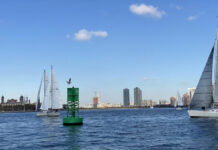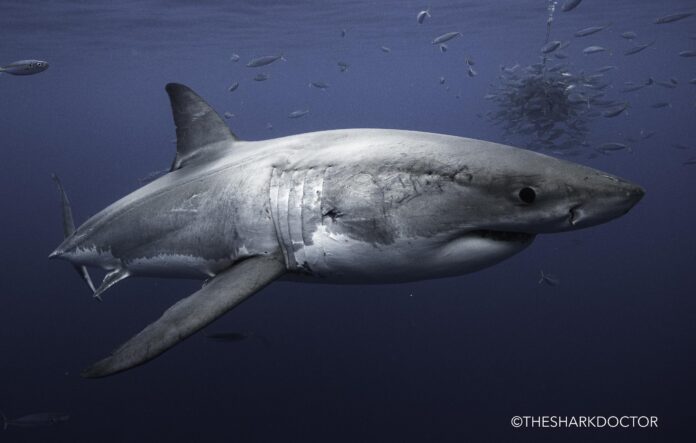New York Harbor’s “front yard”, the New York Bight is defined by the Atlantic Ocean waters and the ocean floor stretching from New York Harbor east to Montauk, and south to Cape May, New Jersey. It is home to the Hudson Canyon, a subterranean formation more than a mile deep. Recent exploration by NOAA and other marine research organizations have catalogued previously unknown species living in the dark depths. Deep corals are but one of the exciting discoveries in the canyon.
The New York Bight will soon be home to New York State’s first wind farm that is set to start construction just months from now. The foundations of the wind turbines will add dozens of new artificial reefs that will support the Bight’s ever-growing ecosystem. Rhode Island’s wind farm is already proving to be a haven for marine cultures as fishing boat charters will attest.
Whales, sharks, and other sea mammals are now in abundance as global warning is changing sea migration and feeding habitats. For those of you interested in learning first hand about the various species occupying the New York Bight, there are many marine programs available. There are a growing number of naturalists who work on our whale watching vessels. Volunteers are always welcome to join sea rescue organizations and our local aquariums also host educational outreach. Scholarships and internships are attracting budding young marine biologists to attend new programs.
There is no doubt the New York Bight is benefiting from the changes occurring in the Atlantic Ocean. As Scuba diving, fishing charter boats, day cruising, and other water activities grow in popularity, science will continue to discover life in the migratory routes, breeding grounds, and ocean nurseries in our marine environment.

Dr. Craig O’Connell is the founder and executive director of O’Seas Conservation Foundation, Inc based in Montauk, along side his wife, Dr. Nicole O’Connell. The nonprofit foundation focuses on researching different species of sharks through camera studies, bycatch reduction technologies, and underwater video surveillance. O’Seas Conservation Foundation also runs a program called “Shark Camp” which educates and inspires High School students to learn many of the basics of what a Marine Biologist does. Beyond O’Seas, Dr. O’Connell is a nature presenter for Discovery Channel’s Shark Week and an adjunct professor at UMass Dartmouth. He’s also a published author and has won numerous awards for his photography.
I had the privilege of interviewing Dr. O’Connell to get his insight on the upcoming 2021 Shark research in the New York Bight along with finding out more about his O’Seas Conservation Foundation. It went as follows:
Marc: I remember reading your interview with Newsday last summer that you observed many young Whites in the New York Bight. Can you explain if there is a difference between White Sharks and Great White Sharks?
Craig: White sharks and great white sharks are the same thing. The media likes to refer to them as great white sharks, but the true common name here in the USA and other locations is ‘white shark’.
Marc: Please elaborate on how the Bight might become a new breeding ground for the White Sharks.
Craig: There is a big difference between breeding grounds and nursery grounds. The New York Bight is a white shark nursery ground. This was discovered by scientists many years ago; however, our team is working to learn more about this nursery ground so we can find ways to better protect the area and the sharks. Now, the breeding ground – that is another exciting thing that many scientists all around the world are trying to locate. Where are these white sharks breeding? There are two known accounts of fishermen observing white sharks breeding; however, there are no photos and videos from these observations. Therefore, many are still on a quest to film the behavior and learn more about the process. Does the entire North Atlantic white shark population breed in the same location, I really don’t know but would hypothesize that it happens over a very broad area, which is why it is so difficult to observe.
Marc: Why do the older Whites still migrate north while leaving their young behind in the Bight if there is an ample food source for them in the Bight?
Craig: Good question. There is ample food for the young-of-the-year (cool term for white shark pups that are less than a year old) and juvenile white sharks, including small fish (mackerel and menhaden), skates, rays, and smaller sharks. However, as sharks age their diet changes (this is called an ontogenetic shift in diet) and they begin to prefer larger and more energetically beneficial food items, such as marine mammals. When the white shark pups arrive in Montauk, the adults are making their way north (e.g. Cape Cod) to feed on seals (and other prey species).
Marc: What projects will the O’Seas Shark Camp enthusiasts be working on this year?
Craig: We are actively conducting a variety of projects at O’Seas. Projects include bycatch reduction technologies (e.g. technologies that aim to reduce unwanted catch from commercial fishing gears), camera surveys to study shark species diversity with baited remote underwater video systems (aka BRUVS), acoustic tagging research that aims to learn about the long-term movements of a variety of shark species that call Montauk their seasonal home, and FinCam technology research (cameras that we temporarily place on sharks so we can learn about their movements, habitat preferences, and feeding behavior).

Marc: Do they get involved in tagging and data collection?
Craig: Yes. Our non-profit strives to educate and inspire the next generation of scientists, conservationists, and biologists. Therefore, we feel that the best way to do this is to get them directly involved in our research efforts. In fact, we run a week-long program throughout the summer known as ‘Shark Camp’. During this week, 9th-12th grade youth from all over the world take part in our work and learn many of basics of what a Marine Biologist does. They participate in activities from boat driving to tagging baby white sharks – so it truly is a one-of-a-kind experience. Nothing quite compares to when one of our students sees a large shark for the very first time – their face lights up and you immediately know they are “hooked.” It is our goal to ensure they have the best experience possible and thus far, our program has been such a huge success and we are grateful to all the support we have received thus far.

Marc: Does the foundation recruit middle or high school age students from New York City for O’Seas’ youth education programs?
Craig: Yes, we try to recruit high school students from all over the world. In fact, we have had students from Singapore, Indonesia, Costa Rica, Canada, and from all over the USA. Our original goal for O’Seas was to raise sufficient funds each year so that this summer ‘Shark Camp’ can be a free experience for 9th-12th grade youth. More specifically, we hoped to raise sufficient funds to provide full-ride ‘Shark Camp’ scholarships to underprivileged children whose families may not have the necessary means to participate in these types of activities. While we haven’t been successful in raising sufficient funds to meet this original goal of a fully funded ‘Shark Camp’ program (e.g. scholarships for all participants), there have been some truly amazing and generous families that have donated to our organization so we can provide up to 5 full-ride ‘Shark Camp’ scholarships each year for the past several years.
If you would like to read more about ‘Shark Camp’ – please check out our website: https://www.oseasfdn.org/shark-camp-cg0o
Should anyone be interested in helping to fund future campers and fund our research, we are actively accepting donations via email or our website: https://www.oseasfdn.org/donate-c1f8a
Marc: Do your education programs also teach its students about ocean mammals such as the North Atlantic Right Whales that are of course critically endangered but often observed off Long Island? I would like to learn more about the relationship between whales and sharks in the New York Bight.
Craig: There are weeks of ‘Shark Camp’ where whales and dolphins are so numerous that no matter where we look, you will see some type of marine mammal. Montauk is truly a special place and even though we focus our efforts on sharks, we absolutely take every opportunity given to us to learn about any types of nature we encounter while on the water. We have never encountered a North Atlantic Right Whale, but we have encountered bottlenose dolphins, common dolphins, humpback whales, minke whales, and fin whales. During certain weeks in the summer, the pods of Atlantic Menhaden (what is known as the fuel of the NY Bight) arrive. This is a preferred prey source for a variety of marine mammals and sharks. During the right time of year, we often look for the pods, keep a reasonable distance away, and watch the humpback whales feed. It is a true treat for everyone involved.
Marc: Does one hunt the other and if so, what species?
Craig: Based on where we are located, we won’t normally see any shark-whale predatory events; however, if we expand the term to marine mammals, it is possible that we could witness some predations between larger white sharks and dolphins or seals. During certain times of the year, the larger white sharks pass through and they most certainly can take advantage of all the prey (harbor seals, grey seals, bottlenose dolphins) that calls Montauk home.
Marc: It has been reported that Orcas are making their way down to Cape Cod and possibly Montauk. As climate change continues to alter the ocean environment, do you see a possible collision between great Whites and Orcas in the North Atlantic or even the New York Bight? I am fascinated by the Orca hunting behavior that has been reported off California or along the coastlines of Australia and New Zealand.
Craig: Global warming is having quite a large impact on marine and terrestrial wildlife all over the world. However, I’m not too sure Orcas will call Montauk home any time soon. Is it possible that they may be spotted on very rare occasions in the future, sure.
Marc: Do you also focus on other species?
Craig: While we focus some of our efforts on white sharks, we work with a variety of other shark species in the New York Bight. More specifically, we work with blue sharks, shortfin mako sharks, dusky sharks, common thresher sharks, and sandbar sharks. What’s important to know is that some of these sharks are experiences huge population declines, therefore, our research is becoming more and more important. For example, the shortfin mako shark is a recreationally and commercially sought after species. Due to this, their populations have plummeted on a global scale and this species is now considered endangered. With continued exploitation, this species may go extinct in our lifetime. Therefore, we must do all we can to protect this species (among many others) if we truly want a healthy ocean for many generations to come.
NYHC will follow and report the research from O’Sea’s base camp in Montauk. No doubt the Shark Campers will have great tales to tell as they explore life in the New York Bight!














